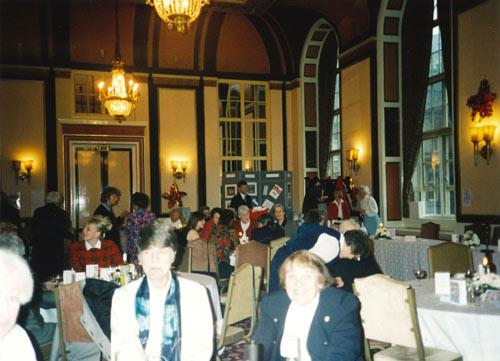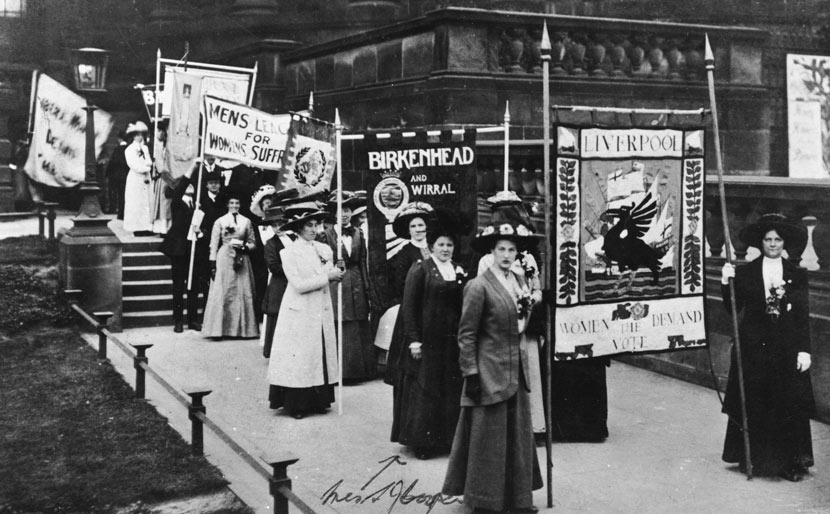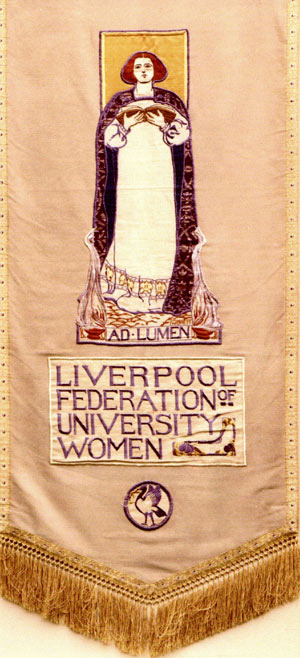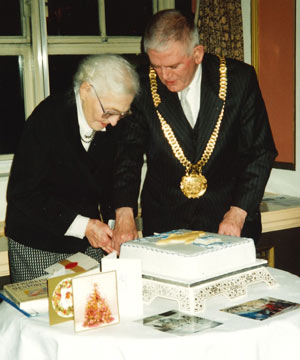University Women banner – revealing histories and mysteries

The British Federation of University Women, (today known as the British Federation of Women Graduates), was founded in 1907 to bring University women together. The following year, a Liverpool Association was formed by Eleanor Rathbone and other local ladies. Members worked for women in the city. Mrs Nan Mackean, former Honorary Secretary of the Association explained -
"They raised money for beds in the new Women's Hospital, campaigned for women to serve in the Police Force, and battled bravely against the introduction of the marriage bar for university women staff, which meant that if women married, they were automatically dismissed from their posts and were unable to continue with their careers. During the 1930s, and in wartime, members welcomed European women who were refugees fleeing from the Nazis, giving them hospitality while they waited for a passage to the USA, and providing them with clothes and money for the journey".
 Women’s suffrage procession outside of Liverpool Central Library in 1910. Photograph courtesy of Lancashire Archives DDX 1137/5/24
Women’s suffrage procession outside of Liverpool Central Library in 1910. Photograph courtesy of Lancashire Archives DDX 1137/5/24
Archive of the Liverpool Federation of University Women, University of Liverpool Library, ref D799. As part of this year’s Vote 100 commemorations (100 years since some women were given the right to vote in 1918), I have been exploring objects in our collections relating to women’s history. I therefore started to research this stunning banner which was made for the Association and kindly donated to the Museum of Liverpool in 2004.
Going through the Association’s minute books and newsletters at the University of Liverpool Special Collections and Archives, I was able to piece together snippets of information about the banner and its conservation (prior to it being donated to us).
Early history
Unfortunately, and rather annoyingly for me, the very first minute book of the group had been lost many years ago, allegedly from the open top sports car of a committee member! So we may never know who and exactly when the group decided to commission the banner, how much it cost etc. Completely by chance, I noticed that the banner was actually featured in a photograph I had seen many, many times; the main image in our Taking liberties display! It can be seen being held towards the back of this women’s suffrage procession outside of Liverpool Central Library in 1910, near the steps and lamp post.
So we know, (if the date of the photograph is correct), that the banner was being used in 1910 and was therefore made around the time of the formation of the Association, or within a few years. It seems very likely that the University women were closely allied to the cause of Votes for Women, especially as many were denied entry into professions at this time. The progress for equal education moved alongside the campaign to give women the vote. Many women campaigned for both, while others felt that education had to come first, so that when granted the vote, women would be well enough educated to use it wisely.
What do we know about the banner?
- The archives revealed that it was used at events such as the launch of the Liverpool Women’s Business Directory, the University of Liverpool Fresher’s Fair and International Women’s Day in 1994, and also a Post-graduate inauguration in 1995.
- The president’s report at the Association’s AGM in May 1995 states that, “Our banner is always an attraction and has been greatly admired”.
- In 1995 the first discussions take place re: getting the banner preserved and cleaned as it is showing signs of wear. Although their newsletter does note that “moving [the banner] from wardrobe to under bed storage to a carrier bag has kept it in reasonable order”.
- A Conservation report in 1999 recommended that it should be sent to a textile conservation studio to be treated and re-packed in a specialised display box.
- In 2000 the association began fundraising to restore the banner. They aimed to raise £750.
How did they raise the money?
Well, in many enterprising ways!
- At Lowood, Lyndhurst Road, Mossley Hill, where many of their ‘At Homes’ were held, members read extracts aloud on the theme of festivities and celebrations
- A Literary Tea with raffle organised by the Book Circle raised over £35
- A musical lottery raised £20
- Sale of a coveted recipe for fruit punch at 50p a copy raised £15
- The fund also benefited from a kind legacy from member, May Barlow
Conservation work
The work, to return it to its former glory, was undertaken in 2000 by conservator J Hyman. (The banner was made by W Brett. It is an applique wool banner with braid and fringe).
Stella Warren cuts the cake with the Lord Mayor, 12 December 1998, Courtesy of the University of Liverpool Library, ref D799 1
Rathbone legacy – full circle
On 12 December 1998 the Association celebrated their 90th birthday at a party at the Adelphi Hotel in the city centre. Jenny Rathone, the great niece of Eleanor Rathbone was invited to speak. Her talk was entitled 'The continuing relevance of Eleanor Rathbone – 90 years on'. There was a special cake and the Lord Mayor was in attendance. It is very fitting that in this centenary year we are celebrating the continued relevance of Eleanor Rathbone and the many women who have made, and continue to make a difference in the city. You can see fantastic items relating to Eleanor and other campaigners in our display Taking liberties: women's suffrage in Liverpool.
There was also currently a display at the Victoria Gallery & Museum, 'Eleanor Rathbone - An Independent Woman'.
90th birthday celebration, The Adelphi, 12 December 1998, Courtesy of the University of Liverpool Library, ref D799 1



